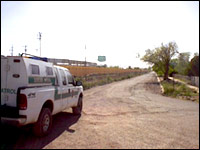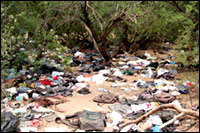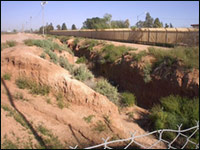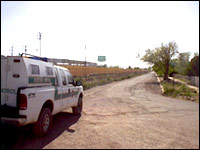In the three-way struggle between the U.S. Border Patrol, illegal border crossers, and the natural environment, it’s never clear who’s winning.

A U.S. Border Patrol truck on the
move near Douglas, Ariz.
Photo: Congressional Immigration Reform
Caucus.
If you ask the Border Patrol, they will tell you they apprehended nearly 1.2 million illegal crossers in fiscal year 2005, and that it was an increase from the previous year. They won’t mention that roughly double that number managed to elude them over the last five years.
Meanwhile, Enrique Enriquez of Grupo Beta, a Mexican group that helps migrants in part by rescuing those abandoned by smugglers in the Arizona desert, will say that the number of deaths in the desert rises every year, with the harsh climate tragically trumping even the best efforts to survive.
Others see the land — especially the sensitive ecosystems of the Sonoran Desert of southern Arizona, where the majority of illegal immigrants have been crossing since the mid-1990s — as another loser in the ongoing battle between immigrants, drug traffickers, and the authorities chasing them.
This month, as the House and Senate gear up for the challenging (some say impossible) task of reconciling their competing immigration-reform bills, many on the front lines are anxious to see major policy shifts that attack the root of the problem, steering people out of the desert and through legal points of entry. For their part, conservationists say the environmental impacts of illegal immigration — like the human ones — are too serious to continue unchecked.
When It Terrains, It Pours
“The sheer number of immigrants and Border Patrol agents pursuing them is having a huge impact on natural resources in the borderlands,” says Sally Gall, a refuge operations specialist with U.S. Fish and Wildlife’s Buenos Aires National Wildlife Refuge near Sasabe, Ariz. Gall and her coworkers face an increasingly difficult mission: trying to take care of 118,000 acres crossed by an estimated 2,000 to 4,000 migrants daily between February and May, when temperatures begin to creep into the triple digits.
Buenos Aires is one of three swaths of protected public lands along the Arizona border, and abuts Mexico for five flat, sparsely populated miles — making it an ideal place to slip across. Besides topography, there’s another reason the spot is popular, says David Bemiller, the Border Patrol Tucson Sector’s public-lands liaison: the patrol is generally stretched thin across the sector’s high-migrant-traffic zone.
While the Border Patrol is in principle required to follow federal laws like the Wilderness Act, which prohibits taking vehicles off-road in wilderness areas, the agency’s law-enforcement prerogative frequently leads officers into remote terrain in pursuit of traffickers.
“The smuggling organizations are very aware of where the protected lands are,” Bemiller says. “They’re aware of where the [Border Patrol’s] restrictions are, and tend to take advantage of them. They exploit the wilderness areas.”

Belongings left behind in the
Buenos Aires refuge.
Photo: Eliza Barclay.
The resulting cat-and-mouse conflicts can cause staggering impacts on the land. According to Gall, an estimated 500 tons of trash are generated on the refuge per year, almost entirely by migrants. (While the refuge is open to visitors for camping and hunting, tourism has significantly declined in the last few years, according to refuge law enforcement, in part because of safety concerns.) Recently, one “staging area” — a spot where migrants are forced to shed most of their belongings before cramming into the vehicle sent to pick them up — was covered by approximately 100 square yards of clothing, backpacks, water bottles, deodorant, and other detritus.
Gall says erosion from the huge number of trails generated by crossings is also worrisome. “We estimate there are about 1,500 linear miles of foot trails,” she says. “Over time, the areas with trails have become devoid of vegetation, and we will see increased erosion, gullying, and trenching as the water runs down the trails during the monsoon season [in July and August].”
Further damage is caused by vehicle chases. “We’ve asked the Border Patrol to try to stick to the roads, but when they’re in pursuit they often go off them,” Gall says, and others confirm that’s also the case in similar protected areas.
Bemiller says the agency has recently made a concerted effort to respect the sensitive environments where migrants often cross. “Our patrol efforts in the wilderness areas are challenging,” he acknowledges. “There are times when environmental laws and concerns are amendable to our operations, and times when they’re not.”
These worries aren’t particular to the U.S. Oscar Moctezuma of Naturalia, a leading Mexican organization that co-manages a private conservation ranch in Sonora, Mexico, with The Nature Conservancy, says migrants and the Mexican Army traverse the ranch daily. “They cross through and contaminate the water sources with their [bodily] waste,” he says. He adds that soldiers sometimes cut fences and shoot deer while looking for traffickers.
Most involved agree that natural-resource problems will never be solved until a larger policy solution is found. “Why are we fighting the Border Patrol?” asks Jenny Neeley, southwest representative for Defenders of Wildlife. “There is no solution on the ground for all the damage to these habitats and sensitive areas. We need … to give migrants an incentive to cross legally.”
Don’t Fence Me Out
If Congress succeeds in hammering out a compromise immigration-reform bill, it could provide that incentive. But it could also take the environmental impacts of U.S. national-security policy to a new and dangerous level.

Fenced section of border in Douglas, Ariz.
Photo: Congressional Immigration Reform Caucus.
The version approved by the Senate last month includes an amendment to build 370 miles of fencing and 500 miles of vehicle barriers along the border. These structures and the stadium-style lighting likely to accompany them could be constructed along remote stretches of the Sonoran Desert and other areas in Texas, New Mexico, and California that serve as corridors for wildlife.
“It’s remarkable that this amendment to build 370 miles of wall sailed through the [U.S. Senate] unopposed by the environmental community,” says Stephen Mumme, professor of political science at Colorado State University and an expert on border environmental policy. “This fence will be one of the greatest impacts on the borderlands environment in the last century.”
If the fence provision becomes law, there’s less wiggle room than one might think to challenge it and other incursions. That’s because the Department of Homeland Security — which houses the Border Patrol — gained the authority in 2005 to waive any U.S. law when border security is at stake.
The agency first invoked the waiver in September 2005, when the Sierra Club and the Audubon Society of San Diego challenged construction of the final segment of a 14-mile fence slated to bulwark the Tijuana Estuary. A district court threw out the case, but according to environmental lawyer Cory Briggs, the groups are filing a new suit claiming that the waiver itself is unconstitutional.
Environmental groups working in Arizona have considered suing the Border Patrol for its off-road operations on public protected lands, says Neeley, but are afraid the waiver will be invoked, further paralyzing environmental legal strategies. “No one is litigating here, because there’s very little recourse if the waiver is invoked,” says Neeley. “Congress would have to enact a new law getting rid of the waiver” to pave the way for a successful suit against DHS, she says.
While environmentalists are alarmed by DHS’s ability to ignore federal laws when convenient, Bemiller contends that environmental laws can hinder the Border Patrol’s objectives. “We are installing rescue beacons [30-foot towers where people in distress can call for help] in the zones with the highest number of deaths, but it’s a two-year process to install each one because of the National Environmental Policy Act,” he says. He adds that NEPA requires the agency to analyze the impacts on endangered species like the Pima pineapple cactus. “Meanwhile, there are people dying in the desert, and we get blamed for it.”
The Rev. Robin Hoover of Humane Borders, a humanitarian group that provides water and first aid for desert-crossing immigrants, is skeptical of Bemiller’s complaint. “[DHS] could get permission to install those beacons in a heartbeat if they wanted them that bad,” says Hoover, claiming that the agency has the ability to move swiftly on high-priority issues.
While the bickering continues between the Border Patrol, humanitarian groups, and environmental groups on the ground in the borderlands, Mumme argues that environmentalists should be trying to get their voices into the high-profile national debate over immigration policy now playing out in Washington.
“The only way to fight this is to insist on being at the table on all homeland-security matters,” Mumme says. “Border security is environmental security, and the consequences, trade-offs, and costs … need to be included in the debate.”



